Crypto Rabbit Holes is a space for me to slow down and pay closer attention to what’s happening and what I’m learning in the crazy, fast-moving world of crypto. If you aren’t subscribed, you can do so here:
You can also find me on Twitter (@_denze) 👋🏻
Note: this piece is now outdated, but is being maintained in a wiki-style format over here. Go there for the latest on the Pixel Vault ecosystem.
Read Time: ~35 mins
Pixel Vault (PV) is one of the most complex ecosystems in the NFT space. What started as a comic on 10 May 2021, has become one of the most ambitious companies in web3, looking to redefine the future of storytelling, media & entertainment, gaming and sports.
With their grand ambitions comes complexity, and unfortunately, their complexity is a double-edged sword. To some, this is what makes them special, but to others, it confuses and puts them off.
In today’s piece, I’ll guide you through the PV ecosystem. There’s a lot to cover, but don’t worry if you don’t know anything about them. I’ll start from the very beginning and build up your understanding piece by piece.
Here’s what you can expect:
PART 1) Pixel Vault’s Story (~10 mins)
A good place to start for valuable context. I’ll tell you origin story of Pixel Vault, and take you through all the big developments so far.PART 2) The Pixel Vault Playbook (~5 mins)
A framework for understanding how Pixel Vault thinks, makes decisions and builds their products & experiences - all the things that makes Pixel Vault, Pixel Vault!PART 3) Pulling apart the Pixel Vault ecosystem (~12 mins)
A one-by-one breakdown of the core purpose & value of each asset with the PV ecosystem. I cover the PUNKS ecosystem, MetaHero Universe, Pixel Vault Founder’s DAO and Pixel Vault Sports.PART 4) Putting together the Pixel Vault ecosystem (~8 mins)
An explanation of how the various PV assets interact with one another. I cover the collection of sets, the gamification of PUNKS Comic #1, the many games of the MetaHero Universe, and the execution of Elite Ape Collector’s Editions for PUNKS Comic #2.
To me, the Pixel Vault Playbook, is the most important piece to understand because it helps pull you away from the details which can be filled with mind-boggling complexity. But, with this framework in mind, no matter products or brands are created, you’ll learn to see how they fit into Pixel Vault’s future. I lean heavily on this section to help explain the current PV ecosystem, so you’ll see what I mean.
Note: nothing in this piece is investment advice. And here’s Pixel Vault’s Linktree, with every important link you need.
Okay, let’s get started with the context.
Part 1) Pixel Vault’s Story
I’ll start at the very beginning, and take you through all the big things you might want to know about PV’s first year:
GFunk meets NFTs
The birth of Pixel Vault
Pixel Vault x WME
Pixel Vault x adidas
Bye bye Beanie
Pixel Vault Inc. raises $100m of funding
GFunk meets NFTs
I can’t tell you the story of Pixel Vault without telling you the story of their founder, Sean Gearin, also known as GFunk or Comicman.
GFunk’s background is in law, entrepreneurship and film/television.
He studied Law at the University of California, Irvine and Loyola Law School, Los Angeles. This led to him starting his career as a Legal Intern at Warner Bros in 2013. After that, GFunk co-founded Qruber Virtual Production Office, a collaboration and workflow management tool for film and television productions. Later, he became the VP of Business Development for Indiepay, an accounting software for production teams. In his final role before founding PV, he was the Head of Growth at Syfer, a cybersecurity company.
In terms of his crypto journey, GFunk has been around the space since 2014.
Back then, any profits he made were used to support his real world businesses. Towards the end of 2020, he discovered non-fungible tokens (NFTs) through NBA Top Shot. Having grown up collecting sports cards, he could see the potential of NFTs in enabling the ownership of digital assets. He quickly fell down the NFT rabbithole; making money flipping projects like Hashmasks, collecting digital and generative art like on Art Blocks, and finding himself welcomed by the CryptoPunks community.
For context, CryptoPunks, a collection of 10,000 pixelated characters, are one of the early NFT collections. They’re widely seen as being historically significant for their role in igniting the popularity and growth of NFTs. For more on this and a backstory of the CryptoPunks, Sandra Upson’s piece ‘The 10,000 Faces That Launched an NFT Revolution’ is a great read.
At that point in time, early in 2021, GFunk noticed many individuals developing brands with their CryptoPunks, like @ClaireSilver12, @punk4156 and @gmoneyNFT . However, with his background in the entertainment industry, he realised no-one was developing intellectual property (IP) behind NFTs in the traditional sense, i.e. by crafting narrative and stories.
The question he asked was:
GFunk: “What if we could create a narrative behind these stagnant on-chain assets, that drove value beyond the collectability standpoint?” (source: Every Punk has a story: GFunk and the PUNKS Comic | PROOF)
And just like that, the concept of Pixel Vault was born.
The birth of Pixel Vault
To start, GFunk teamed up with Preston Johnson a.k.a. SportsCheetah. They had their targets set on building stories around CryptoPunks. But there was one big problem; a lack of capital.
After reaching out to many crypto & NFT influencers/investors, GFunk managed to form a partnership with Beanie. Beanie invested the capital that Pixel Vault needed to launch, and offered up 13 of his own CryptoPunks. Meanwhile, GFunk and SportsCheetah were able to pull together 3 of their own. Without Beanie’s investment, Pixel Vault wouldn’t have been able to launch.
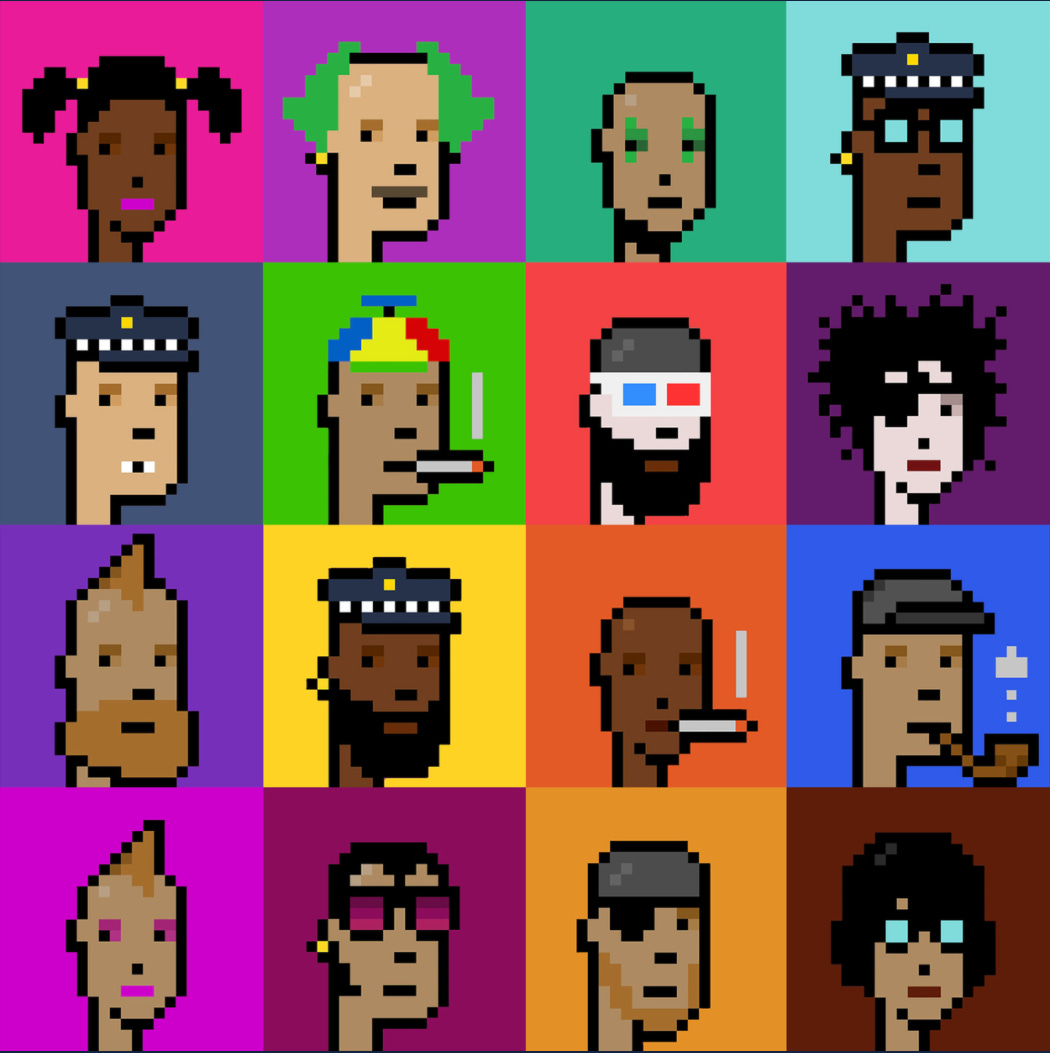
With these 16 CryptoPunks to work with, Pixel Vault launched their first NFT collection on May 10: PUNKS Comic Issue #1. They created characters inspired by the look of the 16 CryptoPunks, and brought them to life through a comic. It took 5 weeks to sell out the 10,000 comics, generating 2,000 ETH in sales.
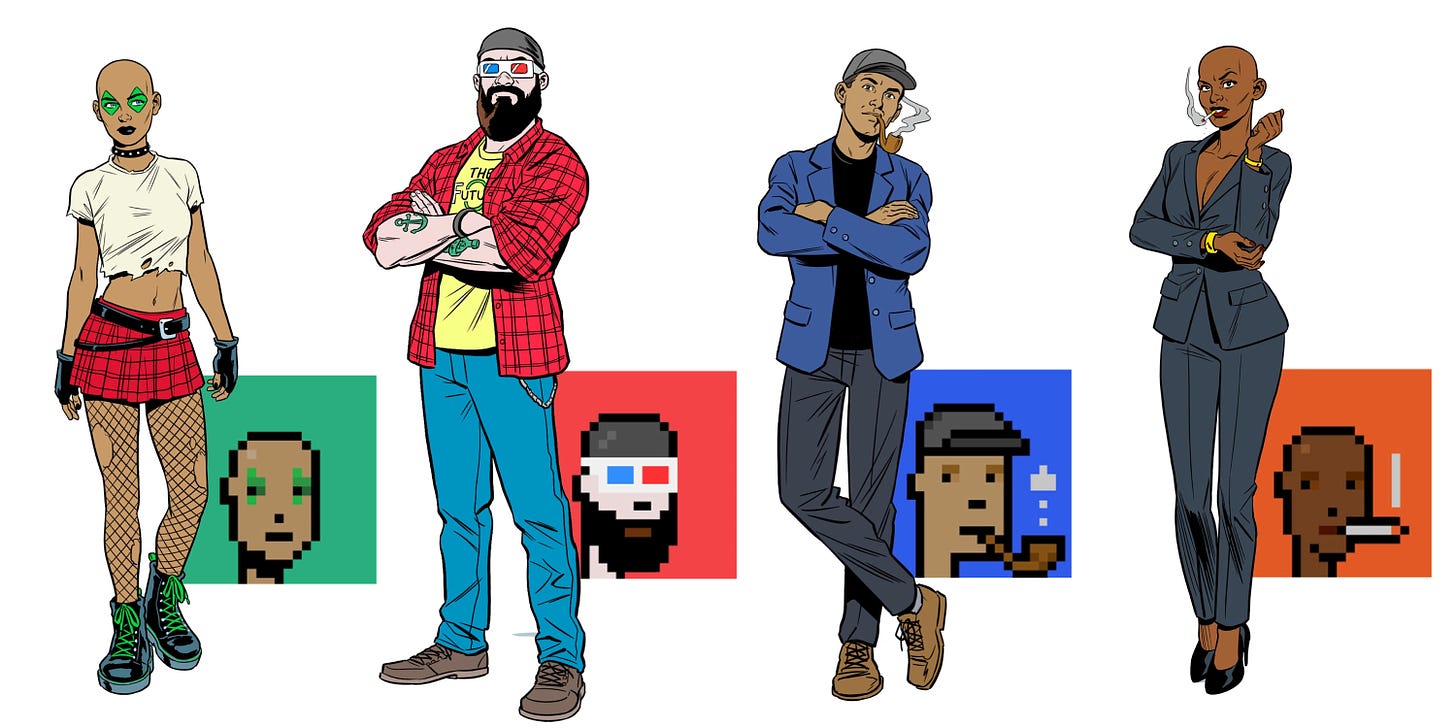
We won’t get into the details of PUNKS Comics yet, but for now, just know that for GFunk, selling out was a big deal. He’s openly shared the fact that he borrowed money from his mum, stepdad and friends.
GFunk: “I was all in with everything I owned and then some, to launch this project. My whole life was on the line with that comic” (source: Comicman: The Exclusive Interview)
Pixel Vault x WME
On 1 October 2021, less than 4 months after selling out PUNKS Comic Issue #1, Pixel Vault signed with William Morris Endeavor (WME); one of the longest running talent and media agencies.


By tapping into the networks and partnerships of WME, PV will be able to push their IP across many different verticals (film, TV, podcasting, gaming) to capture mainstream attention.
GFunk: With WME, you’re not really just dealing with one agent, you’re dealing with subject matter expertise across a variety of verticals. We have someone who’s in legacy publishing - whether that be comics, books etc. We have someone whose sole responsibility is television, we have film, we have digital media, we have a gaming agent. You have all of these people whose sole incentive is to develop business for you as that’s the only way they make money. They don’t collect a cheque from us otherwise. (source: Comicman: The Exclusive Interview)
Pixel Vault x adidas.
On 29 November 2021, Pixel Vault announced another major partnership - this time with adidas, and alongside Bored Ape Yacht Club and crypto investor gmoney. Keep in mind - at this point, Pixel Vault was just over 6 months old.
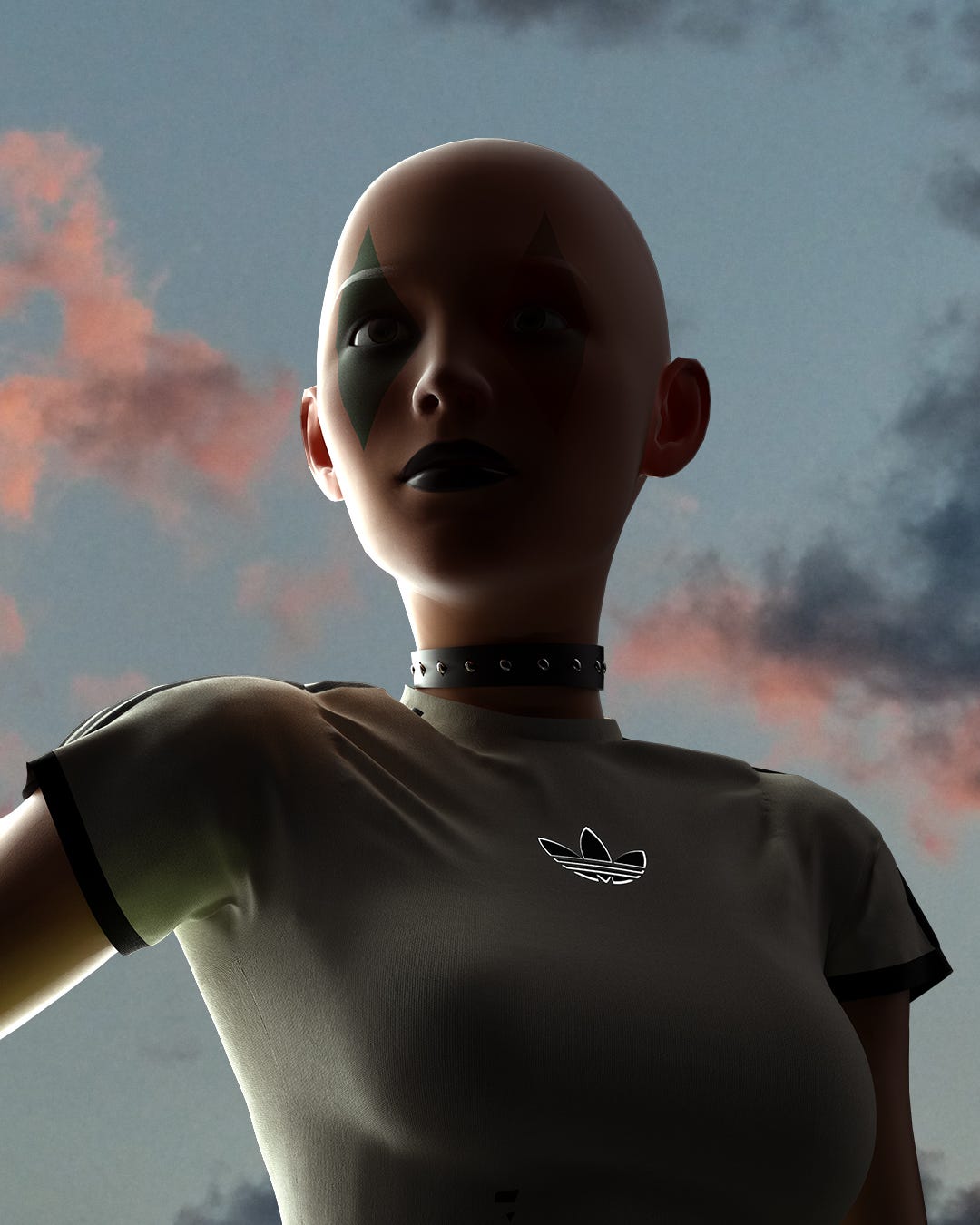
The partnership saw Adidas featured in PUNKS Comic Issue #2, and led to the launch of Adidas’ first NFT collection, called Into The Metaverse. This wasn’t just a one-time collaboration either - to this day, PV continues to work closely with Adidas on their NFT project.
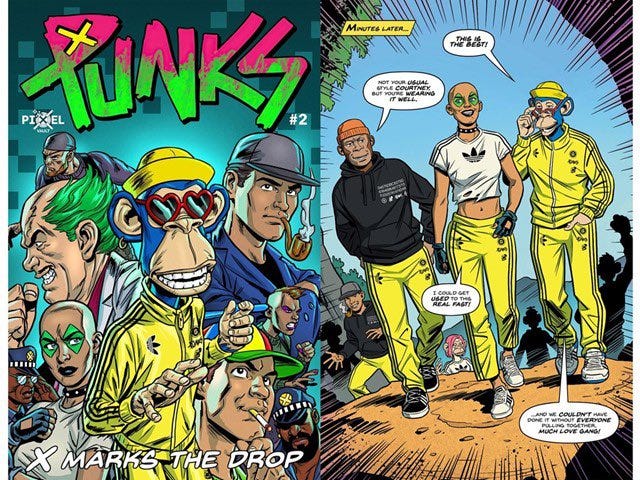
Fun Fact: here’s the inside-story from gmoney, on how this collaboration was put together so quickly

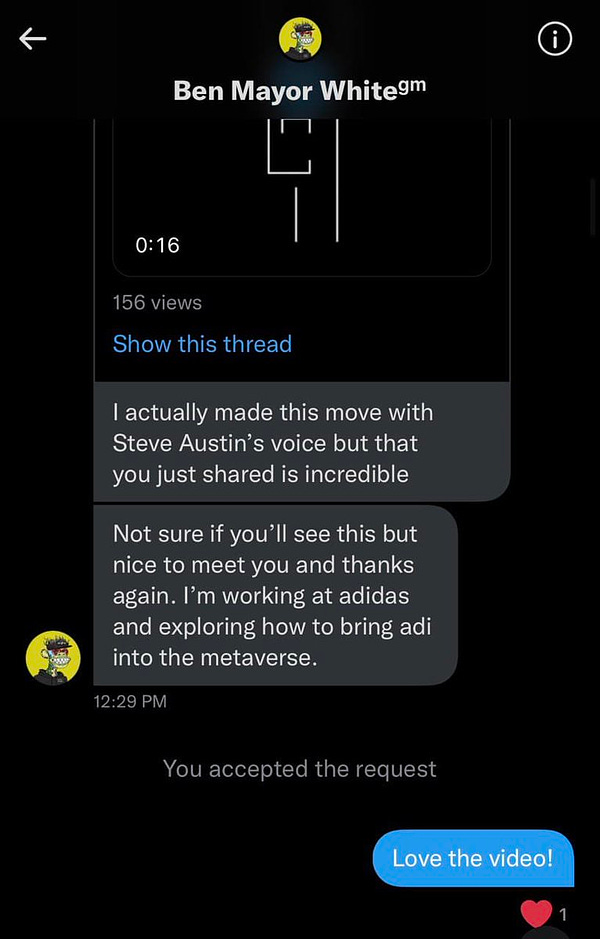
Bye bye Beanie
Beanie’s ties to PV turned out to be a double-edged sword. I won’t get into too much detail about the drama that surrounded him. However, I do think a mention is important given his impact on the history of PV.
On one hand, Pixel Vault wouldn’t have been able to launch without his initial investment. With his large following, he was able to spread the word about PV, and draw a lot of attention to the project; especially with his infamous leaks of the PV roadmap.
On the other hand, he was a controversial figure; respected by some who made money following him, and hated by others who saw him to be quite provocative and misleading. Because of his presence, many avoided, and continue to avoid, entering the PV ecosystem. On 17 January 2022, a thread was published by @NFTethics, suggesting that Beanie was involved in a series of scams.
GFunk responded the following day, announcing PV’s separation from Beanie, which had already been in the works for months. The separation would see all of Beanie’s PV assets returned to PV - as GFunk says:

That was it - bye bye Beanie 👋🏻
However, the drama didn’t end there. Some started questioning why Beanie was receiving royalties from sales of PV assets, and whether Beanie was in fact the one in charge at PV, rather than GFunk.
To summarise GFunk’s response:
Pixel Vault was GFunk’s idea, and he ran the business from the very beginning
Beanie put up the capital & NFT assets to bring Pixel Vault to life, when no-one else was willing to, and therefore he was entitled to some of PV revenues
Moving forward, Beanie has no involvement with PV; he’ll hold no assets and earn no royalties

Pixel Vault Inc. raises $100m of funding
The separation from Beanie quickly led to the announcement of PV’s restructure, with the creation of a new entity: Pixel Vault Inc, owned by GFunk, PV employees and their investors.
Investors…?
The major news on 3 February 2022 was that PV had raised $100m of funding from Velvet Sea Ventures (led by Michael Lazerow a.k.a. Laz), and 01 Advisors (led by former Twitter CEO Dick Costolo and former Twitter COO Adam Bain). For Laz’s inside-perspective on his investment, his post Inside Pixel Vault: The Real Story is a great read.
To get a sense for what this partnership means for PV, here’s what they all had to say about it (emphasise mine):
GFunk: So yes, could we do this completely on our own without raising capital? We could, but it would be slower. And really it has nothing to do with the money, it has to do with aligning ourselves with like minded people with proven track records and operators themselves, right? People that know how to build businesses and people that want to take an active role in in making this the best company and the best, truly native Web3 entertainment experience it can be. And so that has been the focus in all of these conversations, finding the right partners, the right strategic people to help us build because, frankly, the money is not of concern. (source: MetaVault: Jan 12th Town Hall Recap)
Adam, Dick, and Laz have been incredible partners. From the outset, we had been somewhat hesitant to take “VC money.” But what drew me to working with these three guys is that they're operators, they've built businesses, and they really believe in this space and the long term vision for Pixel Vault to be the first decentralized entertainment company (source: MetaVault: Feb 2nd Town Hall Recap)
Laz: Great entrepreneurs, they shine like a pile of diamonds. And that's what Sean has done to form the company and to give the community a chance to succeed at the highest level. (source: MetaVault: Feb 2nd Town Hall Recap)
Adam: I came to Twitter in 2010, when it was less than 100 people, one office location in San Francisco and zero in revenue. And together with Dick, we took the company from 80 people to about 8500 people, in a couple years. We went from zero to $2B in revenue faster than almost any other consumer internet company on the planet. Took Twitter public in 2013, and ran a public company for a bit. And so our focus has been taking those lessons that we learned around building a real company.
You know, the point that we came into Twitter, it was an amazing product. It was time to take it from being an amazing product into an amazing business and company. And so we started 01A after I left Twitter, for this exact purpose, when we realized most people in VC haven't actually built anything before. We wanted to build something for operators by operators, because we feel like we have a good way to relate to the same sort of problems and struggles. (source: MetaVault: Feb 2nd Town Hall Recap)
Pixel Vault turns 1
That all takes us to the present. On 10 May 2022, Pixel Vault celebrated their 1st birthday with a rebrand, and a letter from GFunk to the community.
Here’s GFunk reflecting on PV’s first year:
GFunk: What started as a handful of strangers on the internet has now grown into a team that is FIFTY strong! I have always been of the belief that you should invest in people above all else and we have certainly backed up that mantra this year. Pixel Vault’s greatest differentiator is our team. Bull market or bear, we are a team of builders, relentlessly dedicated to telling great stories and embracing new technology for and alongside our community. We have never been more motivated than we are today. (source: From the Desk: An Open Letter to the Pixel Vault Community)
Part 2) The Pixel Vault Playbook
If you don’t already know, the Pixel Vault ecosystem is complicated. Because of that, it’s important to understand how PV thinks about building their products, and designing experiences. Keep this in mind and you’ll have a better shot of making sense of the assets within their ecosystem.
There are 3 aspects which make Pixel Vault, Pixel Vault and form what I’ll refer to in this piece as the Pixel Vault Playbook:
develop crypto-native IP assets, and tell their stories
make web3 fun
build web3 idea legos
Develop crypto-native IP assets, and tell their stories
To make sense of Pixel Vault, we first need to understand their vision and ambitions. To put it simply, they’re trying to build universes as big and as compelling as Disney and Marvel. They’re doing this through the power of storytelling, and across a broad range of channels. Think: comics, television, movies, video games, consumer goods, real-life experiences and much more.
However, there’s one major difference between Pixel Vault & Disney: PV is building with web3 technologies & principles.
GFunk: “We do not look at the fan as the customer. Our fans are the owner and the builder.” (source: Pixel Vault banks $100 million in funding to chase an NFT media empire)
To break that down:
Fans as owners: PV develops “crypto-native IP assets” in the form of non-fungible tokens (NFTs). The power of NFTs is that they let us own things on the internet. Imagine owning one of the characters who appears in the latest Marvel movie! The rabbit-hole of what NFTs enable is deep, but the point is - PV wants their IP assets to be owned by their fans. That way, the success of PV in building a broad fan-base through the stories they tell and the media they create, is the fan’s success as well (as value accrues to the IP assets over time).
Fans as builders: IP assets in traditional media companies are tightly protected. However, PV wants to build alongside their fans, rather than treating them as customers and passive consumers of their media. For example, PV will let their fans contribute to stories, and also give full commercial rights to owners of some of their IP assets. Since fans are owners, they’re incentivised to help build with PV.
Ultimately, Pixel Vault is the umbrella company for all the different brands and IP that they’ll develop over time. Not everything they do will or has to connect together, because different people will naturally connect with different things. However, what ties everything they do as a company together, is their focus on telling stories.
We don’t know where else we’ll see these stories yet - but with their WME partnership, we can be sure that PV is looking to capture mainstream attention.
GFunk: We’re an IP business leveraging next generation technologies. We’re still approaching IP in a way that’s very similar to what these legacy institutions are doing, but we’re doing it in a way that actually benefits the broader community. This collective mind of our community all working together to develop this IP is going to be tremendously disruptive to legacy institutions. You’ve seen Amazon and Netflix already disrupt what the traditional studios were doing, and I think this is the next logical progression of where that’s going. (source: Comicman: The Exclusive Interview)
Make web3 fun
One thing Pixel Vault has become renowned for, is gamifying the collector experience. I’ll go through the nitty-gritty details of this in Part 4, but for now, know this:
PV wants each person’s collection of their assets to reflect their own decisions - based on their unique personality, personal preferences and risk appetite. Being one of their collectors is like being a part of the game that is Pixel Vault, orchestrated by GFunk and his team.
This all stems from GFunk’s desire to create an active, engaged and fun collector experience.
GFunk: At the end of the day, NFTs should be fun. If it's not bringing a smile to your face, you're doing something wrong (source: Every Punk has a story: GFunk and the PUNKS Comic | PROOF)
It’s a lot of - do you do Option 1 because of X & Y, or Option 2 because of Z. In the first instance, it may seem like one option is clearly better. But then there’s the game theory element. What if more people go with Option 2, does Option 1 start to become preferable? And then what if Option 3 is unexpectedly introduced?!

However, PV is thinking more broadly than just the collector experience. They want to make participating in the web3 ecosystem more fun and easy in general. For example, they’ve talked about gamifying DAO participation to incentivise more engagement. For context, the experience of being in a DAO has typically been quite bland and disjointed, i.e. reading through proposals and sharing feedback on forums, and then voting on a separate platform.
Jacob (Pixel Vault’s General Counsel): It's going to be fully custom from the backend and the front end, it's beautiful. It's amazing, and it's probably gonna be done, we have a target date of July 1. I really think it’s gonna set a standard for what DAOs should be doing, which is not relying on fragmented voting and forum mechanics, but instead having a streamlined process and looking for ways to really increase participation. (source: MetaVault: May 11th Town Hall Recap)
This ties in nicely with third and final aspect of the PV Playbook.
Build web3 idea legos
Packy McCormick, who writes Not Boring, talks about the concept of idea legos. He argues that in web3, every new experiment is a building block for the future; a lego piece that anyone can pick up and use. Even if the things being built look silly or stupid, everything helps to compound human knowledge, enabling us to build faster & potentially solve more and more complex problems.
Pixel Vault are constantly building new idea legos which solve problems within the space, and push the boundaries of what’s possible using web3 tech.
These legos not only enable PV themselves to build faster and create new experiences, but it helps the broader space too. For example, if PV’s custom interface for DAO participation is a success, that could quickly be adopted by DAOs everywhere, given its a problem shared by the space in general.
I’ll point out other idea legos as I take you through their ecosystem, but for now, here’s the idea lego that started it all:
GFunk: At the time PUNKS Comics launched, no one had focused on stories. Communities had started to develop stories but nothing had been intentionally done through the creators themselves. It's a powerful legacy that virtually every project that is worth something and doing something in this space is leaning into stories. (source: Pixel Vault Town Hall: 11 May 2022)
Keep those 3 aspects of the Pixel Vault Playbook in mind, and you’ll have a better chance of making sense of all the assets within the PV ecosystem.
Part 3) Pulling apart the Pixel Vault ecosystem
In this section, I’ll take you through the PV ecosystem, one asset at a time. To keep it simple, I’ll intentionally skip over a lot of details, and instead, focus on the core purpose and value of each asset. In Part 4, we’ll look at how the various assets interact with one another.
For now, we’ll go through:
PUNKS ecosystem, including PUNKS Comic and Origin Stories
MetaHero Universe, including Planets, MetaHero Identities, Sidekicks and Mintpasses
Pixel Vault Founder’s DAO
Pixel Vault Sports
PUNKS
The PUNKS ecosystem is an ongoing series of comics which tells the stories of the characters within the Pixel Vault universe. It’s best to think of the comics as collectibles. If PV is to succeed in building their universe and telling stories in the long run, they’ll need to make a lot of comics.
We know PV does like to make collecting fun, so sometimes, there are perks attached to the various comics. However, bear in mind that it’s unrealistic to expect every comic to come with utility and fun, beyond your enjoyment of the art and story.
Right now, the ecosystem includes: PUNKS Comic & Origin Stories.
PUNKS Comic
PUNKS Comics are ~20-30 page comics which tell the story of the PUNKS; the characters who are based on the 16 CryptoPunks owned by Pixel Vault. They’re illustrated by Chris Wahl, an illustrator who’s worked for clients like Marvel, Lucasfilm, DC Comics and more. The comics in this series are initially released digitally as NFTs, but holders can also claim a physical edition.
PUNKS Comic Issue #1: The Hunt for the Lost Robbies is Pixel Vault’s genesis NFT. It’s our first introduction to the PUNKS, following their journey searching for the “Lost Robbies,” which are a big part of crypto-art history.
PUNKS Comic Issue #2: X Marks the Drop tells the story of a treasure hunt for what ends up being adidas clothing. In a way, it’s documenting adidas’ real-life partnership with PV, the Bored Ape Yacht Club and gmoney; merging the digital and physical worlds. The story is also being brought to life as the adidas clothing that appears in the comic will soon be produced and shipped out as physical merchandise to eligible holders of adidas’ NFT collection.
PUNKS Comic Issue #3 is set to come out in June 2022. What we know so far is that we’ll see our PUNKS gain superpowers. Very Marvel-esque. It’s going to be the crossover between the PUNKS and the MetaHero Universe, which is Pixel Vault’s 2nd brand / IP.
Origin Stories
Origin Stories are a series of short (~5 page), digital-only comics. They’re intended to explore the back stories of PUNKS Comic characters, letting us take the time to get to know them outside of the PUNKS Comic series.
Origin Stories #1: Mad Clown, Sad Town is the first of the series, exploring the backstory of Courtney, one of the lead characters.
MetaHero Universe
The MetaHero Universe is a world with heroes, villains, mutants and more, who exist in an ecosystem with 9 planets and 1 moon.
There are 2 main things to expect from the MetaHero Universe:
storytelling & media: we don’t know much about this Universe yet. PV has scattered hints and there, but we can expect to learn more soon, starting with PUNKS Comic #3. However, the big news to date (announced in May 2022) is that Blur Studio (who has worked on films like Deadpool and created the Netflix series Love, Death & Robots) will be working on the MetaHero Universe
web3 games: PV’s main goal is to build out the MetaHero Universe into a decentralised gaming platform that’ll be owned and governed by fans. It’s the PV playbook of making their fans owners AND builders. In traditional games, assets and in-game currencies are limited for use within the game. The promise of web3 games is that by storing in-game goods and currencies on-chain, users are empowered to own them, take them elsewhere and even sell them
So far, there are 4 key components of the MetaHero Universe: Planets, Identities, Sidekicks and Mintpasses.
Planets
Conceptually, Planets are the setting for the MetaHero Universe. Each Planet has their own distinct environment, and it’s where Universe’s stories will take place, and where the characters come from. Mirroring our real world, there are 9 planets (Pluto made it!) and 1 moon.
Structurally, each Planet is designed to be its own decentralised autonomous organisation (DAO). Collectors are able to purchase and own Planetary DAO tokens. The best way to think of these tokens is that they represent your proportional ownership of, and therefore voting power in, the specific Planet.
PV’s intention is to create an interactive gaming experience, giving individuals a voice to decide what their Planet does, and what happens on it; which could affect the revenues the planet generates, and even the future gameplay experience.
GFunk: You have direct exposure to the ultimate success of the gaming platform that we’re trying to build together. (source: Comicman: The Exclusive Interview)
Here’s each of the planets and their corresponding supply (determined by the real-world radius of the Planet in kilometers).
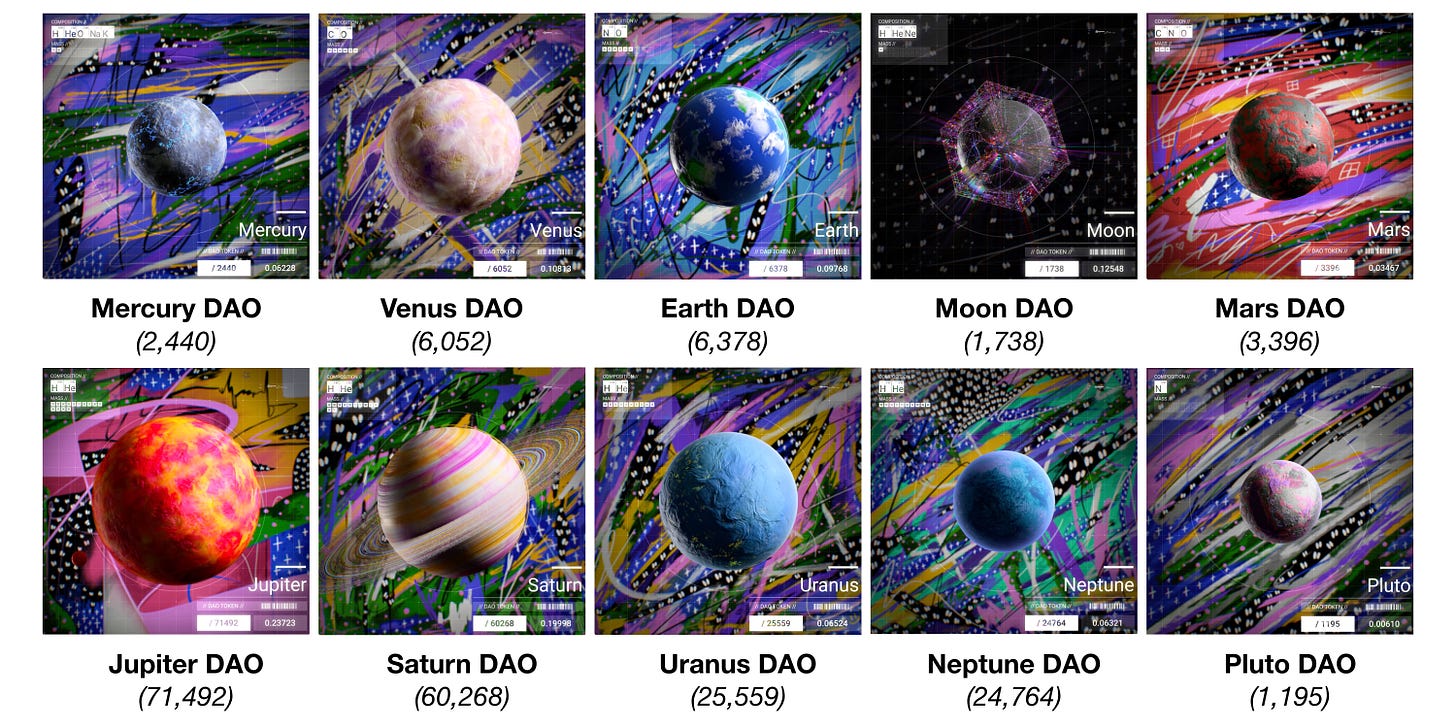
To give you an example, if you owned 244 Mercury DAO tokens, you would have 10% voting power for what happens on Mercury (244/2440 = 10%).
The high supply of the planetary DAO tokens is one of PV’s idea legos. At the time of launch, a collection this big was unheard of in the space, which tended to stick to a maximum supply of ~10,000, in line with the CryptoPunks. However, it’s a signal of the size of PV’s ambitions to reach a wider audience, as well as their desire to make their project inclusive.

Beyond the 10 Planetary DAOs, there’s one other organisation in the MetaHero Universe - the United Planets DAO, or UPDAO. Think of it like the Federal Government or United Nations. It’s where every Planet comes together to make decisions on behalf of the MetaHero Universe as a whole.


The way the Planets fit into the UPDAO is that each planet has a fixed amount of voting power. To continue the Mercury DAO example, Mercury has 5 out of 193 votes within the UPDAO, giving them 2.6% voting power. That means if a decision needs to be made by the UPDAO, Mercury would vote on their position amongst their 2440 DAO token holders, and their final decision would have a 2.6% sway within the broader UPDAO.

MetaHero Identities
MetaHero Identities are the characters of the MetaHero Universe, who come from the various planets. They’re Pixel Vault’s first profile picture (PFP) NFT collection and will later become in-game characters within the MetaHero gaming platform. Keep in mind, PV sees their fans as builders too, so holders of MetaHero Identities have full commercial rights to build products/brands around their Identities.
They’re made up of:
146 Core MetaHero Identities (Cores)
9678 Generative MetaHero Identities (Generatives)
Core MetaHero Identities are specially created characters who will be featured in any forms of media (e.g. comics, television or movies) created by Pixel Vault. However, just because PV will use Cores in media, it doesn’t mean holders can’t either. They also get commercial rights.
The 146 Cores includes:
2 special identities, which will be used as ambassadors for the MetaHero Universe
40 male and 40 female MetaHero concepts
4 versions (regular, hero, villain and mutant) of each of the 16 PUNKS
Generative MetaHero Identities are created by randomly combining the traits of the Cores. What makes these special from an artistic and technological point of view is that each identity is generated at the time of mint.
To explain what that means - every trait you see on a Generative is an individual image layer that’s been randomly combined together by an algorithm. That’s also how many other PFP NFT collections tend to create their assets too - however, the difference is in most cases, the artist will review the outputs of their algorithm, and curate the best of the best for the final collection. Being generated at the time of mint means that with the Generatives, there’s no human input. Given the image layers can be combined in basically an infinite number of ways, and you don’t want to end up with any weird layering errors, this is technically and artistically difficult to do. Especially because you can’t go back to fix it.
In true PV fashion of making the collecting experience fun, easter eggs were also hidden in the Generative Identities. For example:
some backgrounds had signatures of the PV team. So far there are only 2 in circulation.
alternative colour variants for certain traits, like Shiny Pokémon. Keef managed to spot many of these:


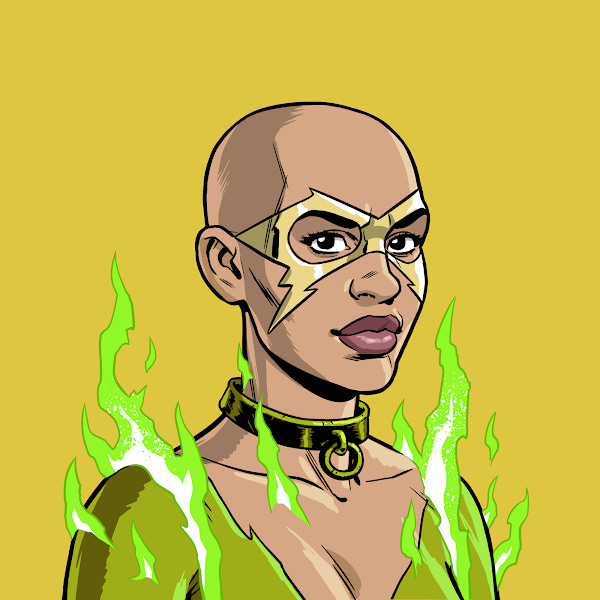
Sidekicks
Sidekicks is the project codename for additional characters and creatures that will be part of the MetaHero Universe. They’re PV’s next PFP collection, which will come in 2 parts:
DOTs are characters that’ll come in 7 different tiers, with varying sizes and skill levels. They’re created by a fictional company in the MetaHero Universe called Genesynth Industries
Species (tentative name) which are native to each planet, will be discovered by the DOTs, as part of the MetaHero game
At this stage, we know very, very little about what PV has planned for Sidekicks. It’s safe to assume that like the MetaHero Identities, they’ll have a big role to play in the story PV is crafting, and will be usable in the game as well.
Here’s what we do know:
GFunk: “It will be the most complex PFP project in history, by far. But it’s gonna be awesome.” (source: MetaVault: May 11th Town Hall Recap).
Mintpass
Mintpasses are essentially a reservation system for NFTs, and another one of PV’s web3 idea legos. They’re the keys to getting MetaHero Identities and DOTs.
You can think of it as unopened trading card packs - you know there’s a trading card (or in our case, an NFT) inside, but you don’t know what it is until you open it.
What makes that so special?
Well, prior to MintPasses, new launches of NFT projects were first-come, first-serve. This was problematic at the time because:
to make transactions on a blockchain like Ethereum, users pay transaction fees (i.e. gas fees)
while there’s a limit to the number of transactions which can be processed in each block, users can choose to pay extra for their transaction to be prioritised
first-come, first-serve NFT launches created a dynamic where users would choose to pay high amounts of fees in a rush to mint their NFT before the supply ran out, also known as a gas war
Gas wars favour those with the most capital, so Pixel Vault conceptualised the MintPass in July 2021 to enable more fair & equitable NFT drops. The concept was quick to be adopted by other teams and is now extremely common.
Right now, there are two Pixel Vault Mintpasses.
In both cases, they were either provided for free or at a low cost to existing holders of PV assets, as a reward for their support:
MintPass #1 is the ticket to getting a MetaHero Identity. Each MintPass #1 can be exchanged for a Generative, at any point in time. However, to make things fun, it also acts as a raffle ticket for a chance to win one of the Cores. This was reserved for purchase by PUNKS Comic #1 holders, for a cost of 0.08 ETH.
MintPass #2 will be used to receive one of the DOTs. Each MintPass #2 can be exchanged for the lowest-tier DOT (Tier 1). However, they can also be used to upgrade the tier of existing DOTs. There are no details of the upgrade mechanics yet, but it’s going to be “exponentially deflationary”. This was distributed for free, for each Planet or MetaHero Identity held by collectors, with certain bonuses which entitled collectors to additional MintPasses.
Pixel Vault Founder’s DAO
The last core piece of the PV ecosystem is the Pixel Vault Founder’s DAO (PVFD).
Like the planets, it’s collectively owned and governed by owners of PVFD tokens. You can think of the PVFD as a company - only in this company, every team member is a passionate PV fan:
every member brings their unique skills, knowledge and perspectives to the broader community and DAO
the company is a close partner to Pixel Vault, as members get exclusive access to GFunk and the team through a private Discord channel
unlike a traditional company, every member has proportional ownership over the DAO’s growing vault of assets, and the power to vote on what the DAO does
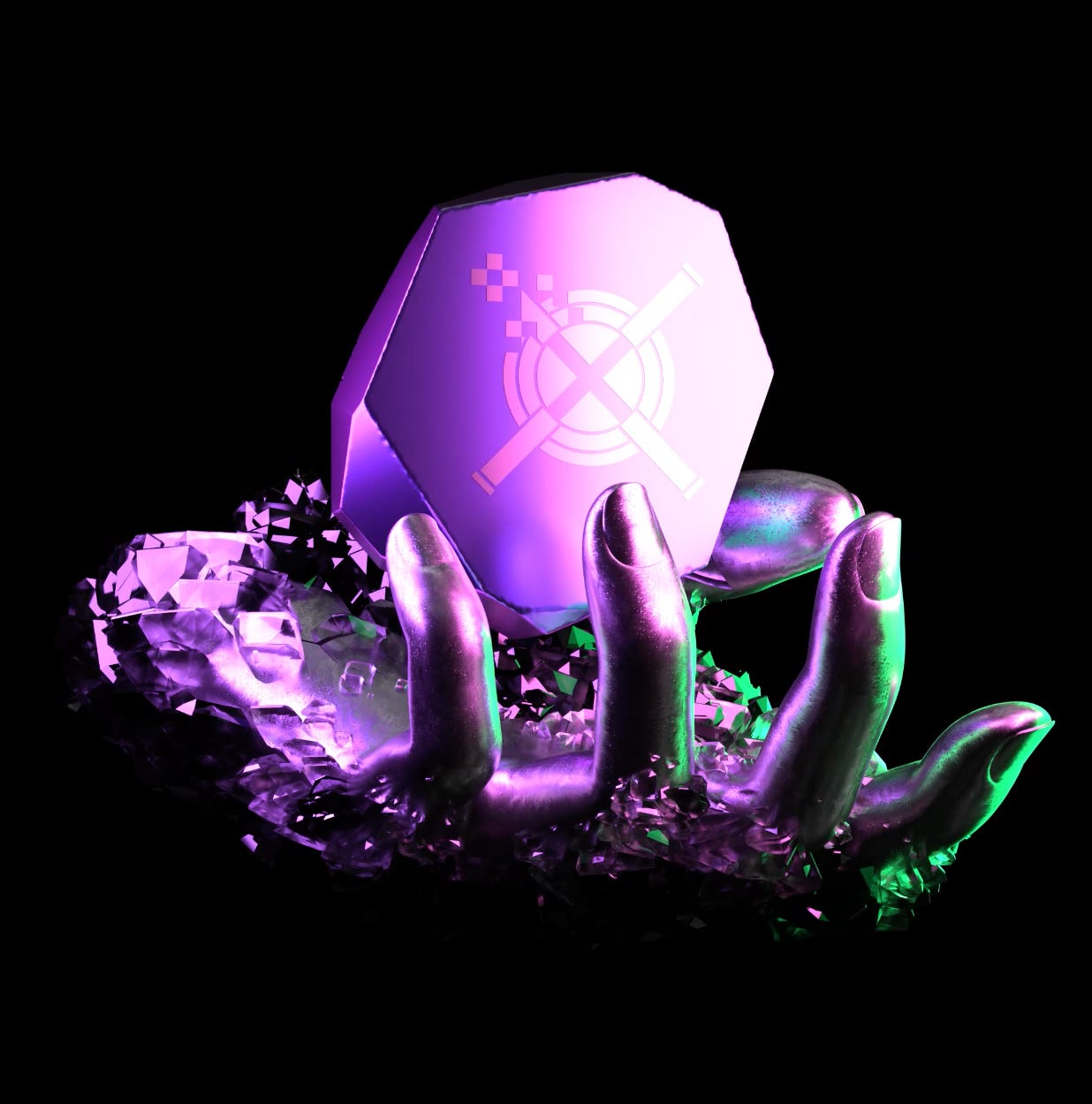
One key point to remember is that Pixel Vault is the umbrella company for everything they’ll create over time. That means those in the Pixel Vault Founder’s DAO are exposed directly & indirectly to everything PV does. Directly, through PV’s decisions to reward PVFD holders with exclusive or priority access to their products, and indirectly, through ownership of PV assets in the vault.
As we know, GFunk sees fans as owners and builders. That’s most true with the PVFD. PV regular distributes assets to the Founder’s DAO vault, and to PV, the Founder’s DAO is a partner who’ll co-create and build alongside them. There’s really no limit to what the PVFD can choose to do together.
GFunk: So the long and the short of it is we want to keep the PVFD engaged and by our side, but we also want it to have its own voice and ability to to do its own things. So, you know, it's sort of like a partnership with with our company (source: MetaVault: May 11th Town Hall Recap)
Pixel Vault Sports
Pixel Vault’s latest venture is into the world of sports, led by Tzvi Twersky. There’s not much to say on this just yet. So far, it sounds like we could see PV creating fun ways to tell stories of athletes and by doing so, onboarding a whole new group of fans into the world of web3.
GFunk: we want to give an opportunity for inclusivity and to welcome more and more people into this Web3 environment in a way that speaks to them. And today, all of the the projects that have focused on sports have really leaned into the idea of digital trading cards, and that is not what we'll be doing. We’ll continue to be storytellers, driving awesome utility to these tokens, one-of-one type experiences, access to different events. (source: MetaVault: May 11th Town Hall Recap).
The biggest news to date is the announcement that Pixel Vault has secured 2 big partnerships with Major League Baseball (MLB) and Ultimate Fighting Championship (UFC):


Part 4) Putting together the Pixel Vault Ecosystem
Now that you have some idea of what each of the PV assets are individually, let’s get to the fun part - how they all fit together:
I cover:
collecting in sets
the gamification of PUNKS Comic #1
the many games of the MetaHero Universe, broken down in 4 phases
PUNKS Comic #2: Elite Ape Collector’s Editions
Collecting in Sets
As part of PV’s desire to create an engaged and fun collector experience, they’ve announced a few official sets.
Genesis Set: PUNKS Comic #1, PVFD, MetaHero Identity, MintPass #1
Planet DAO Set: 1 of each of the Planet DAO tokens
Genesis Comic Set: PUNKS Comic #1, PUNKS Comic #2, PUNKS Comic #3
Holding one of these sets is a signal to PV that you’re one of their early or passionate supporters. Because of that, PV tends to provide additional rewards to set holders. For example, Genesis Set holders received 4 free MintPass #2’s, and were entered into a giveaway to receive a free Earth DAO token.
You can see the importance of sets within the community, by seeing how proudly members flaunt their sets:

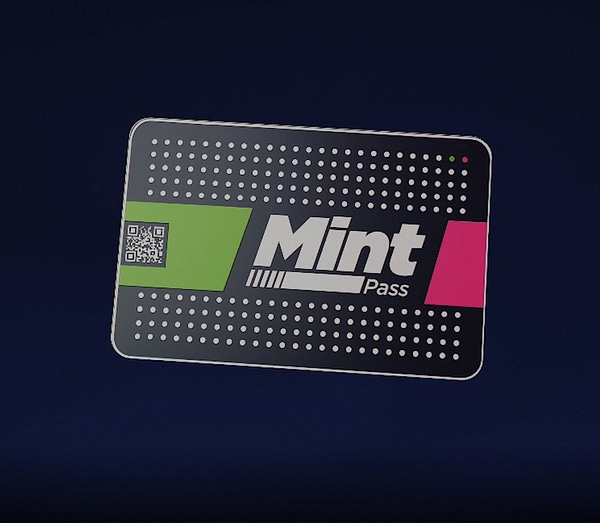
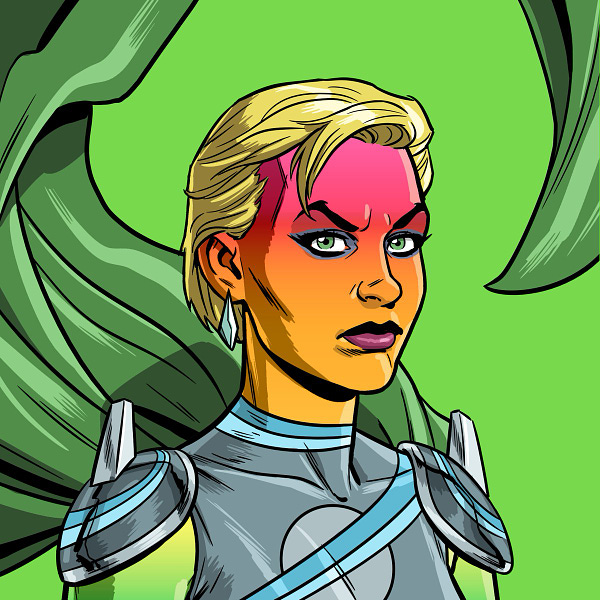
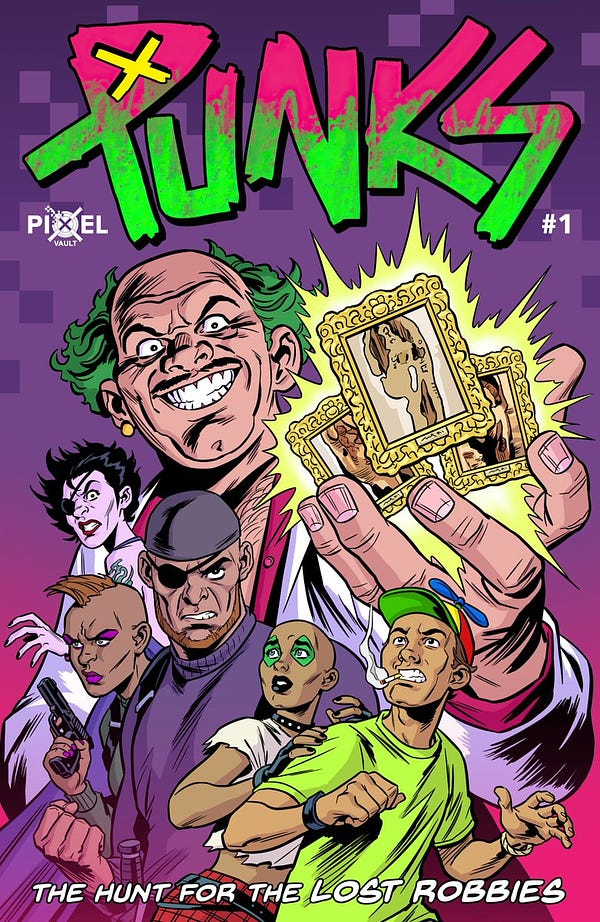
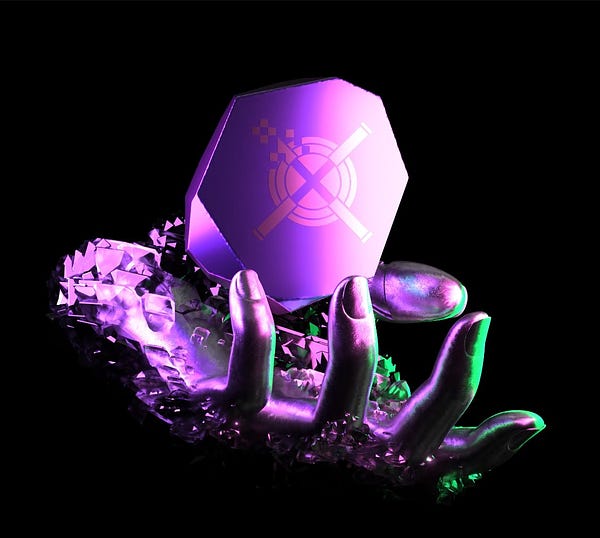
The gamification of PUNKS Comic #1
At its core, PUNKS Comic #1 is a historical Pixel Vault asset - it introduced the world to PV as well as the characters and stories of the PUNKS. However, it’s much more complicated than that.
One of the unique benefits of Comic #1 is that it enables holders to gain proportional ownership over the 16 CryptoPunks which inspired the PUNKS characters. Here’s how it works:
the 16 CryptoPunks were locked into a vault via the platform Fractional
Fractional created 100,000,000 $PUNKS tokens to represent ownership of the 16 CryptoPunks in the vault. More on $PUNKS here.
PUNKS Comic #1 holders can stake (i.e. lock away) their comic over 2 years to earn $PUNKS tokens
Through $PUNKS, PV is leveraging the capabilities of web3 to make their fans owners of their valuable IP assets. Soon, $PUNKS owners will be able to build alongside PV as well, by deciding how stories develop.

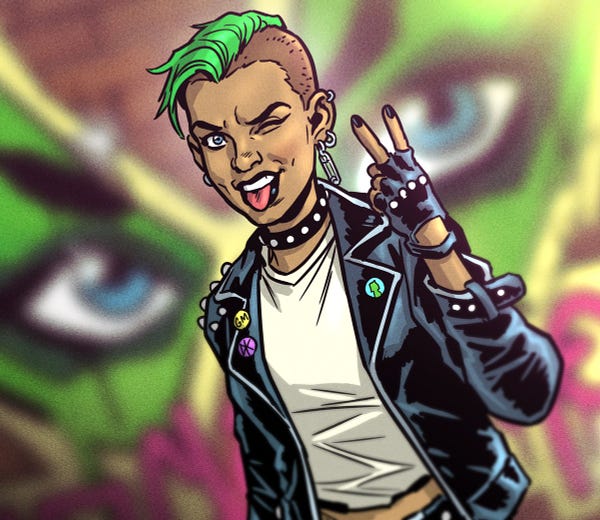
However, there was a lot of PV fun and game theory with Comic #1, because it was the key to two of Pixel Vault’s most exclusive DAOs: the Pixel Vault Founder’s DAO and the Moon DAO.
To receive either of those DAO tokens, holders needed to burn their PUNKS Comic #1. This essentially means permanently removing the comic from the available supply, and giving up the option to stake it for $PUNKS tokens, as well as the right to claim a physical copy.
Collectors had to decide for themselves what they valued most, e.g.
did they care most about the comic, for its value as a collectible (as an NFT & as a physical comic) and the ability to gain fractional ownership over the 16 CryptoPunks?
did they want to be part of the Pixel Vault Founder’s DAO, for ownership over the vault of assets, exposure to everything PV creates, and the chance to hang out, and build with all the other passionate Pixel Vault fans?
or were they more excited by the MetaHero gaming platform, and the opportunity to be part of one of its most exclusive and influential DAOs?
and the game theory - if more are burning for PVFD or Moon DAO, does that make Comic #1 more valuable, given the $PUNKS earning rate increases?
In the end, the original 10,000 supply of PUNKS Comic #1 has fallen to 3371. Alongside it are now 5902 PVFD tokens, and 710 Moon DAO tokens.
Fun Fact #1: if you do the math, 3371 + 5902 + 710 = 9,983. Here’s what happened to the missing 17.
Fun Fact #2: Bad actors exploited a vulnerability which let them burn PUNKS Comic #1 NFTs that they didn’t own, and receive Moon DAO tokens. 58 comics were affected. In response, Pixel Vault compensated those affected with a Special Edition Comic #1, and re-issued the Moon DAO tokens. The exploited Moon DAO is now called The Dark Moon.
The many games of the MetaHero Universe
We know the assets within the MetaHero Universe are part of a game that’s in development, but what kind of game? While there’s a lot that still needs to be revealed by PV, it’s helpful to think about the game in 4 distinct phases:
Phase 1) The gamification of MintPass #1
As we know, MintPass #1 is the ticket to getting a MetaHero Identity. Pixel Vault has given holders 2 choices:
burn the MintPass and receive a Generative; or
hold onto it for the chance of winning one of 144 Cores, which are raffled out in groups of 12
At first glance, it seems obvious that you should test your luck for a Core. However, PV doesn’t make it that easy. There have been a lot of benefits to holding a Generative:
1 free Planet DAO token; dependent on the planetary origin of the Generative, which is randomly assigned at mint
2 free MintPass #2
the option to stake for $POW, the in-game currency of the MetaHero game. 20% of the 1 billion $POW tokens was set aside for those staking their MetaHero Identities. One interesting thing to note about $POW is that 20% of the supply was distributed amongst the PV team and their investors; meaning there’s a clear incentive for them to create value for $POW. That, coupled with its incoming use in the game, makes staking quite lucrative
Just as with PUNKS Comic #1, PV forces collectors to make decisions based on their preferences and risk appetite, e.g.
do you burn your MintPass to see if you’ll get a rare Generative?
do you want the guaranteed benefits of having a Generative, or do you give those up for the chance at winning a Core?
do you want to have a Genesis Set, and the potential perks that may come from it, or do you prefer the guaranteed rewards from having a Generative?
and the game theory element - if more people are burning their MintPass #1, the odds of winning a Core increase, so do you continue to hold?
You can see why this game has been ongoing since August 2021. It’s hard to know if/when it’ll end given the chance of winning a Core, and the potential rewards of holding a Genesis Set.
Phase 2) The gamification of MintPass #2
We know MintPass #2 can be exchanged for the lowest-tier DOT (Tier 1), or used to upgrade existing DOTs to a max of Tier 7. As you can imagine, collectors will need to make a lot of decisions on whether to keep or upgrade their DOTs.
Phase 3) The first iterations of a web3 game
The first iteration of the MetaHero game (referred to as the “DeFi game”) will let collectors interact with their Identities, Sidekicks and Planets, in an environment where they’ll likely use and earn $POW. The experience will be designed to support Pixel Vault’s storytelling, and most importantly, be fun.
Phase 4) AAA Game
In the long term, Pixel Vault aspires to build a AAA web3 gaming experience in a 3D environment, and what GFunk calls “one of the biggest decentralised experiments that’s ever existed”:
GFunk: Imagine you have Fortnite, but owned by the community instead of Epic Games. We just recently signed with WME and one the major reasons we did that is for their partnerships in gaming. They’re part owners of Epic Games, couple of their agents just came over from FaZe Clan. We’re going to attempt to take on one of the biggest decentralised experiments that’s ever existed through these 10 DAOs all working together, planet by planet. It’s a technical and sociological experiment. (source: Every Punk has a story: GFunk and the PUNKS Comic | PROOF)
For now, this is the main update:
GFunk: In partnership with a global, indie studio focused on the future of AAA games, we are working to bring the MetaHero Universe to life within an immersive 3D environment within the next year. (source: From the Desk: An Open Letter to the Pixel Vault Community)
PUNKS Comic #2: Elite Ape Collector’s Editions
PUNKS Comic #2 is a special part of Pixel Vault’s history as it marked the company’s partnership with adidas and the Bored Ape Yacht Club. Within the comic, 8 Bored Ape characters, collectively known as the Elite Apes, were brought to life, and also onto the covers of limited edition comics (750 supply of each). The backstory of the Elite Apes’ partnership with Pixel Vault, makes PUNKS Comic #2 even more special.
In June 2021, shortly after releasing PUNKS Comic #1, Pixel Vault held a bracket style competition called Ape Madness. They allowed the Bored Ape Yacht Club community to submit names and backstories of their Apes. Pixel Vault narrowed down the submissions to 64, and then allowed PUNKS Comic #1 holders to vote on their favourites over 3 rounds, ultimately leaving 8 winners - the Elite Apes.


The partnership is a testament to Pixel Vault’s commitment to storytelling, and making web3 fun. What stands out is PV’s willingness to collaborate and build bridges with other NFT communities. Beyond that, for the release of the Elite Ape covers, PV also created another web3 idea lego with a new drop mechanic - an on-chain queue system. It created a fair opportunity for all those within the Pixel Vault and Bored Ape Yacht Club ecosystems to participate without any gas wars.
Closing Thoughts
Pixel Vault’s commitment to storytelling started with GFunk and now permeates through all that they do. It shows up most clearly in their ambitions to elevate crypto-native IP assets into expansive universes, filled with compelling stories and characters to worlds as big and influential as Disney and Marvel. Can they achieve such a lofty goal? It’s impossible to say.
What we know is that they’re clearly not looking to do this alone. They’re building big partnerships that’ll inevitably open up opportunities, and empowering their fans to own and build alongside them. Whether they get there or not - Pixel Vault has proven that they'll make every step along the way fun for their collectors, and that they’ll relentlessly create new idea legos that push the boundaries of what’s possible in web3.
Remember, it’s only been a little over a year since a cash-strapped GFunk bet his life on Pixel Vault. Let’s see what they’re capable of with the capital, team, experience, partnerships and community that they have now.
What'd you think of today's email?



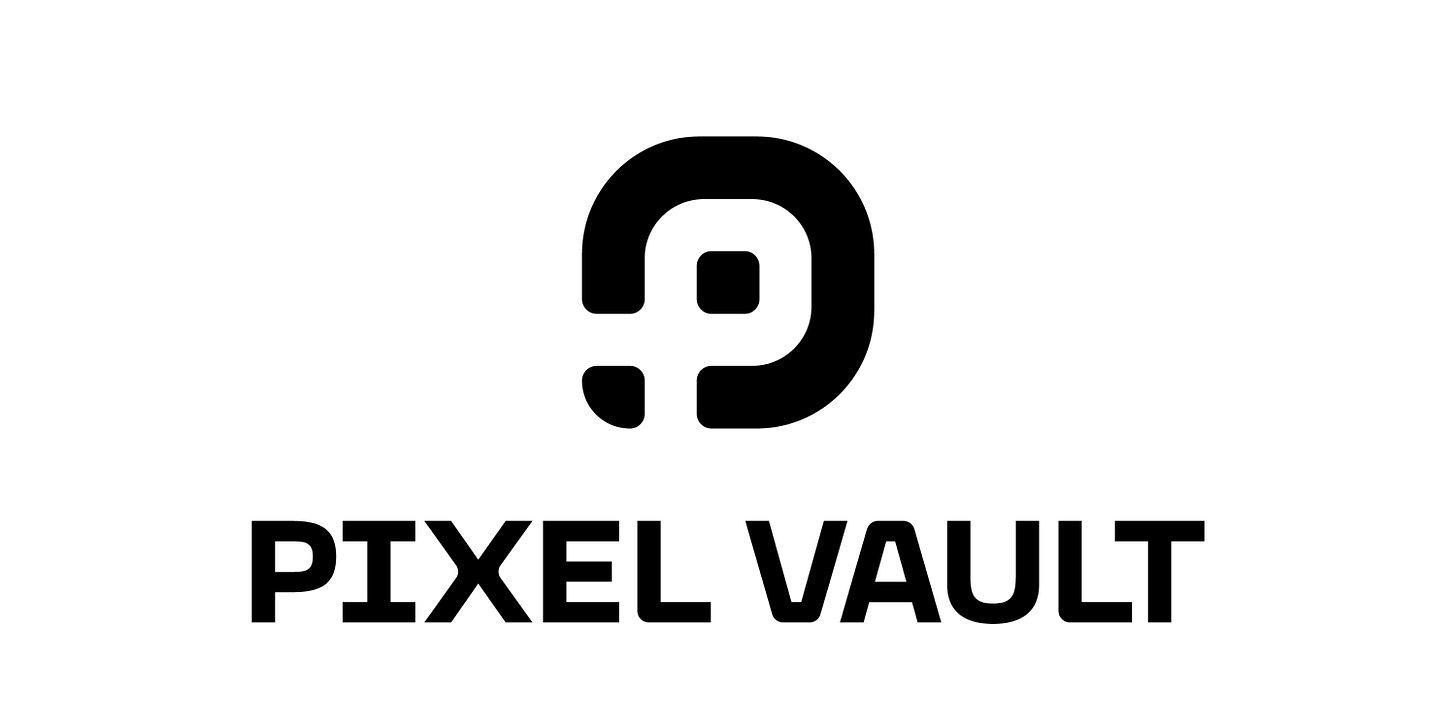
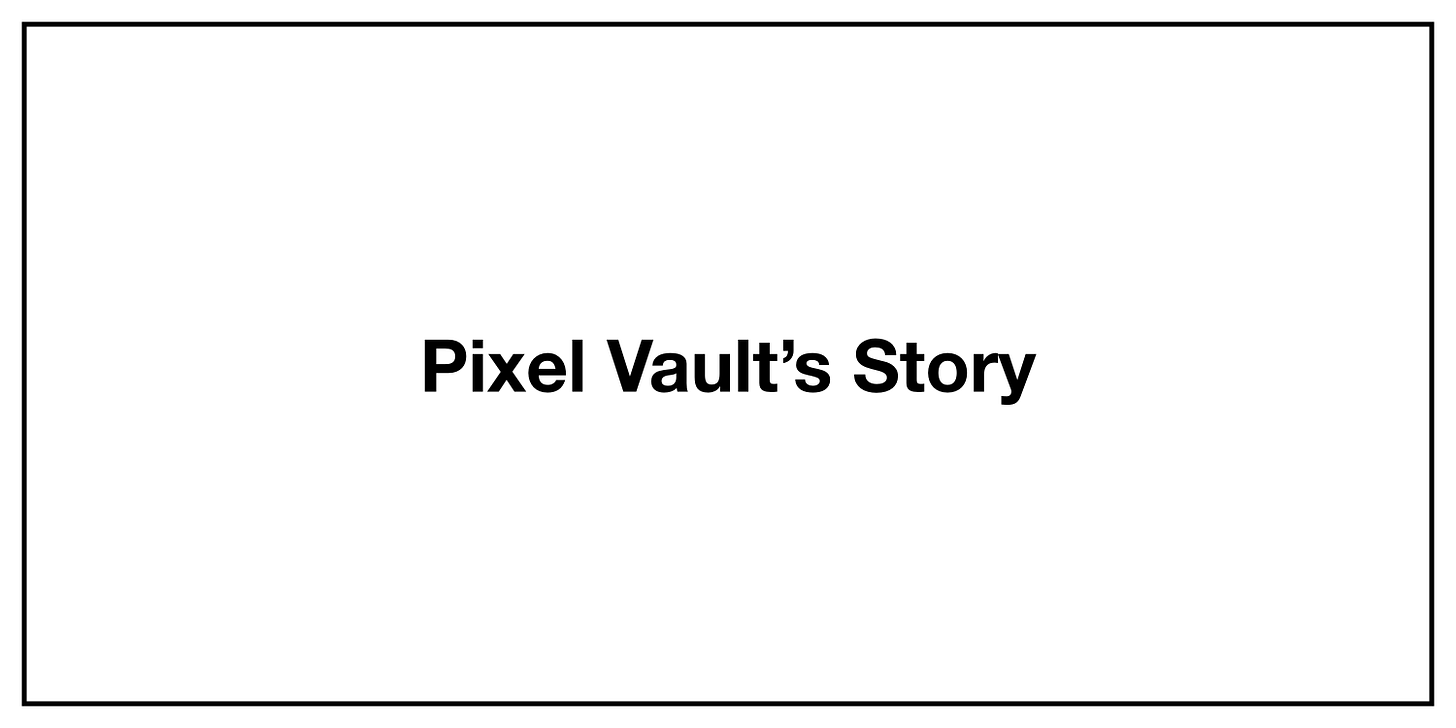
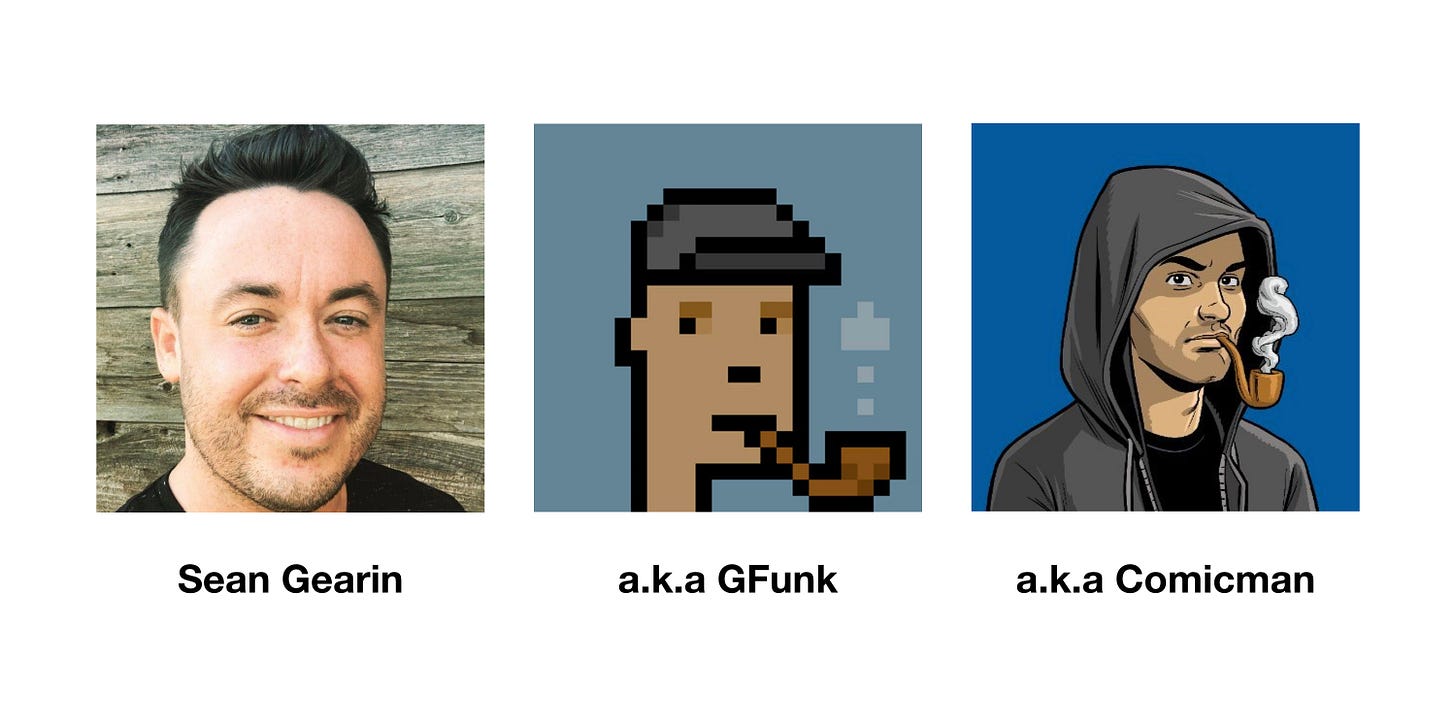

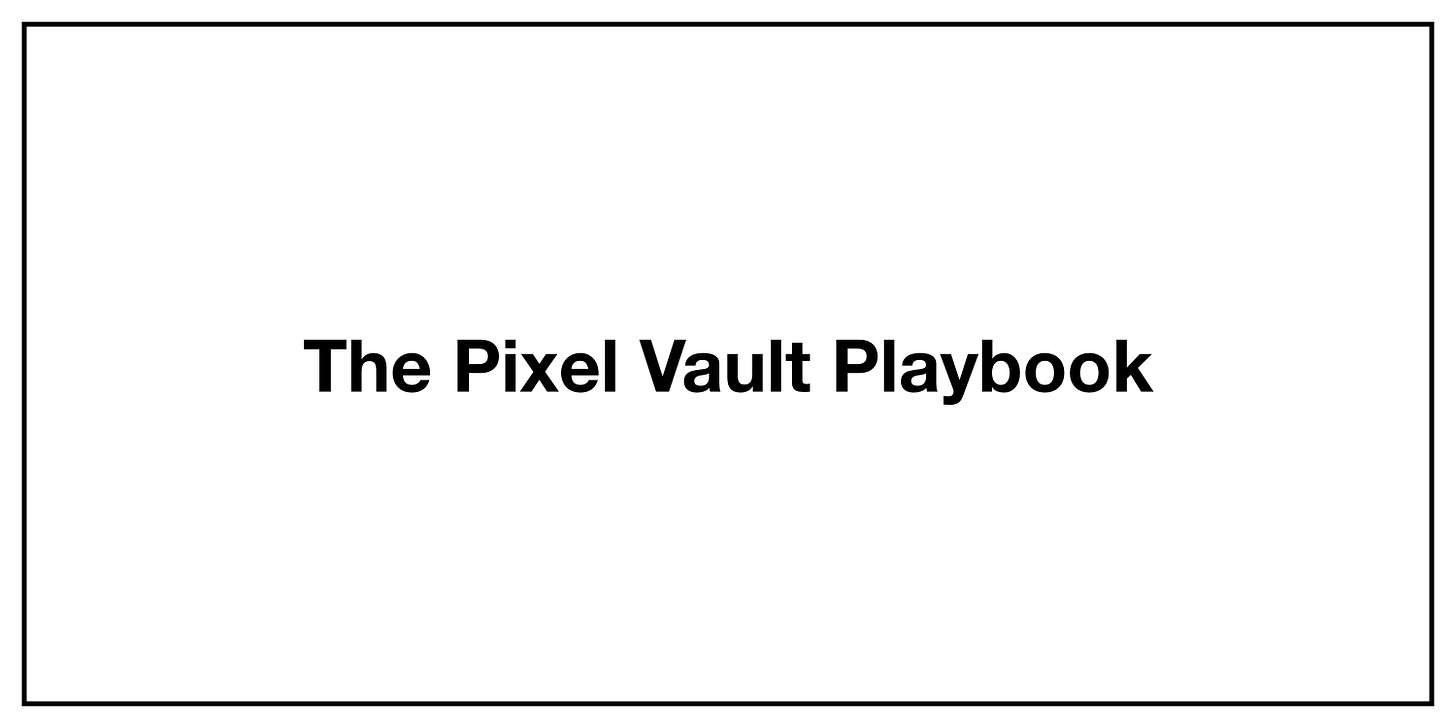
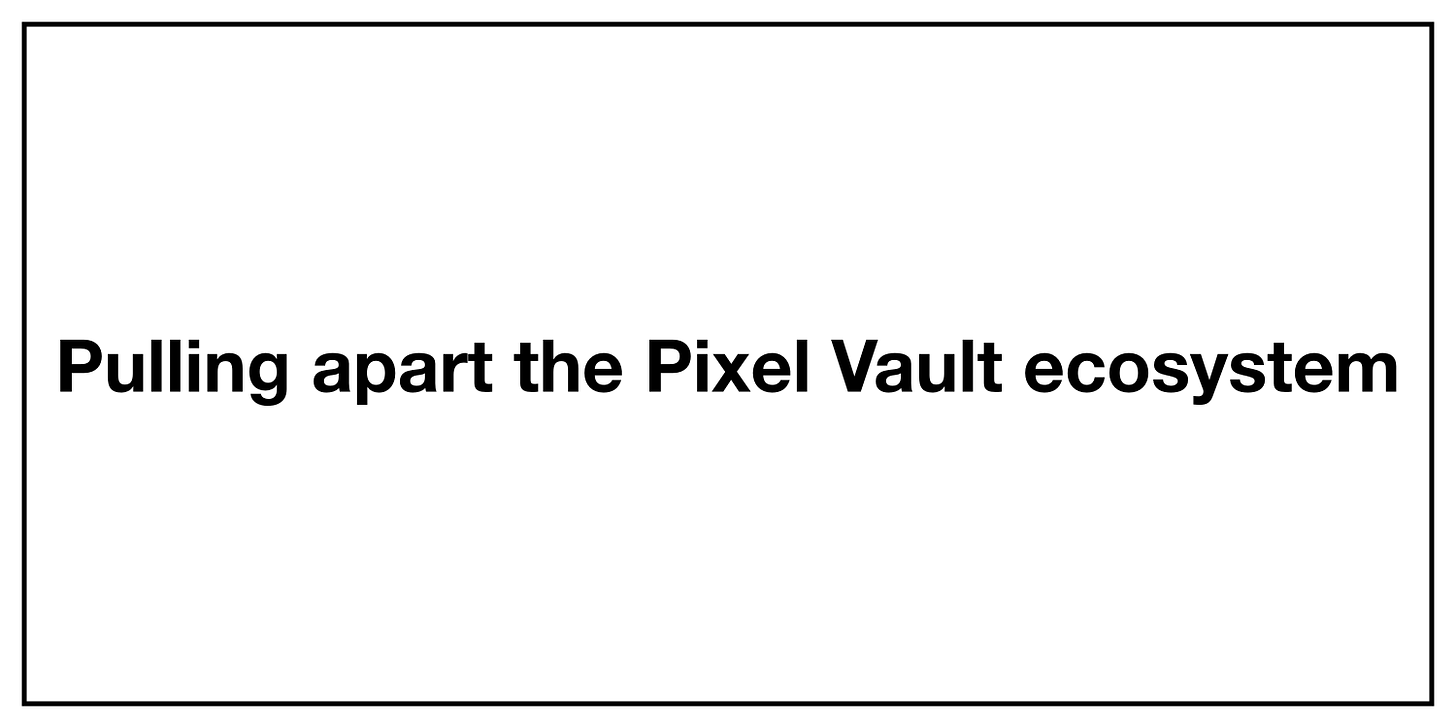

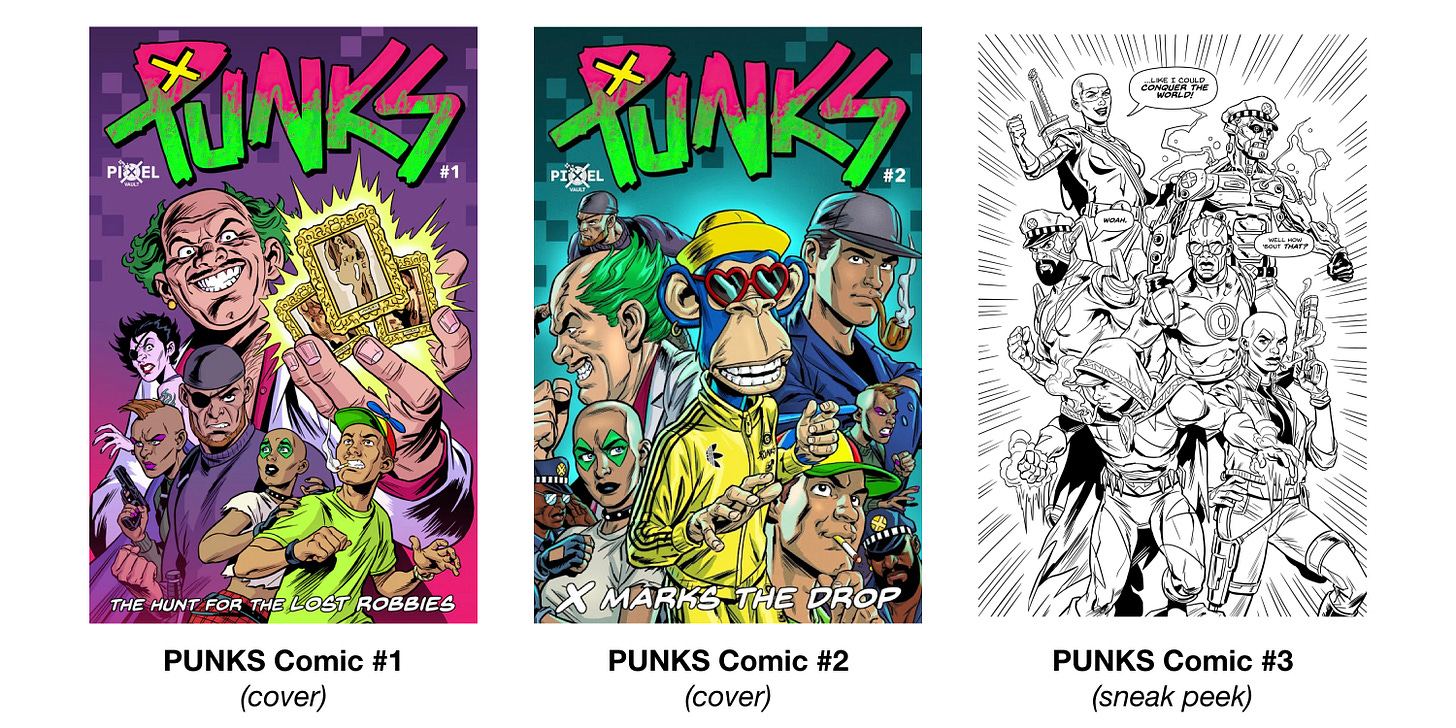


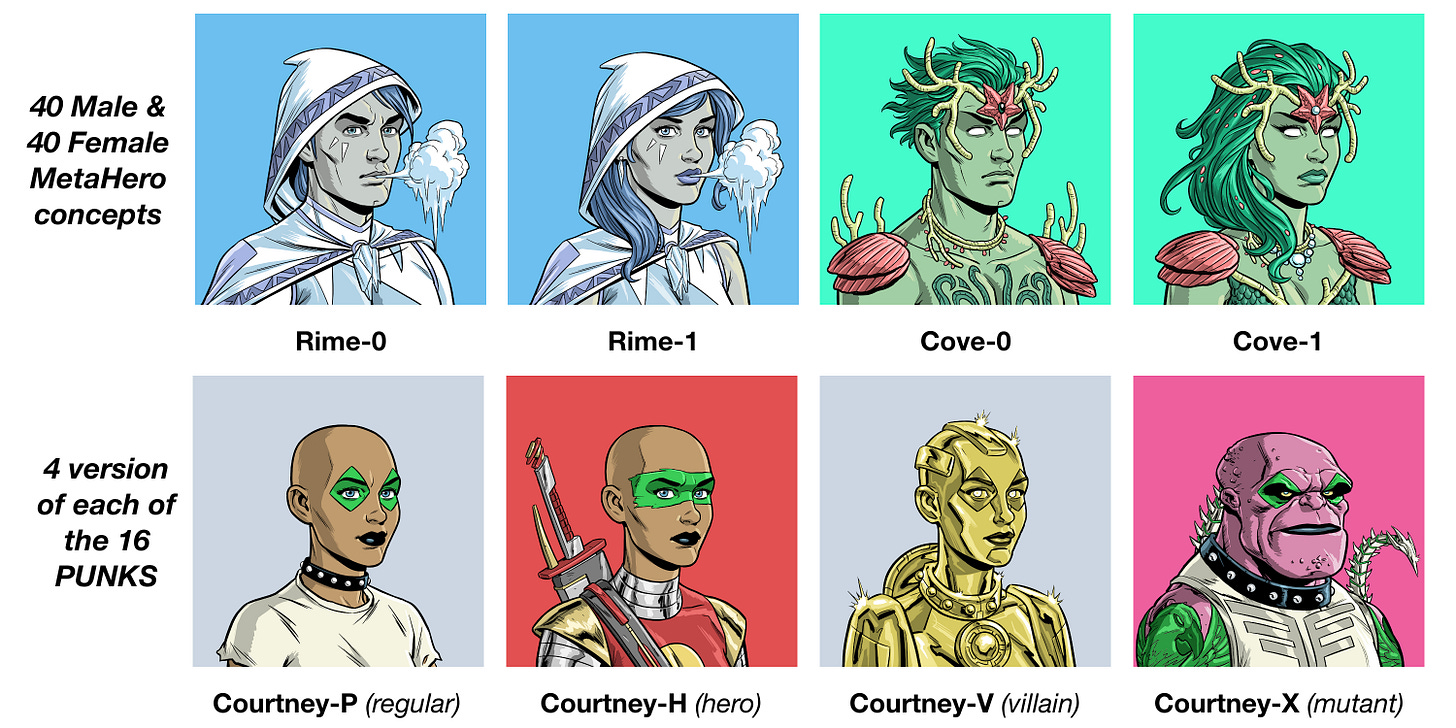
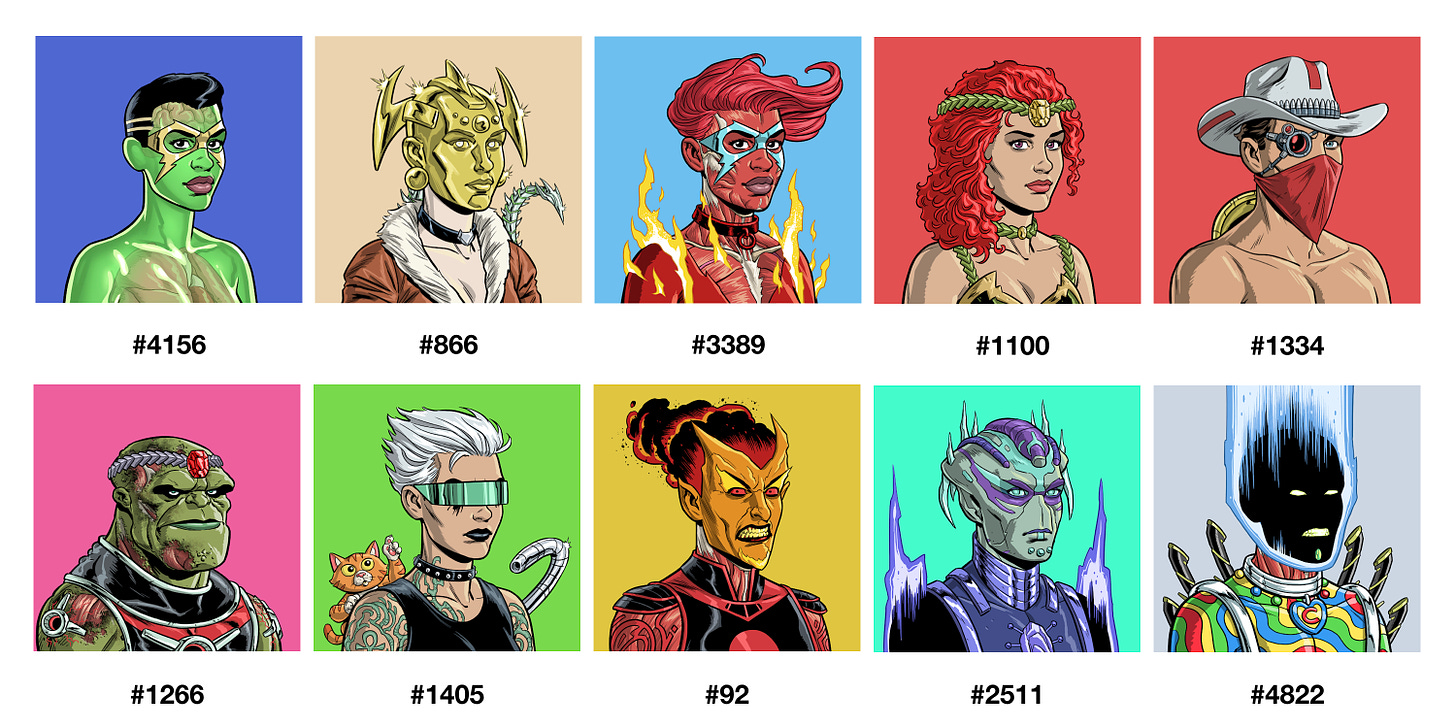

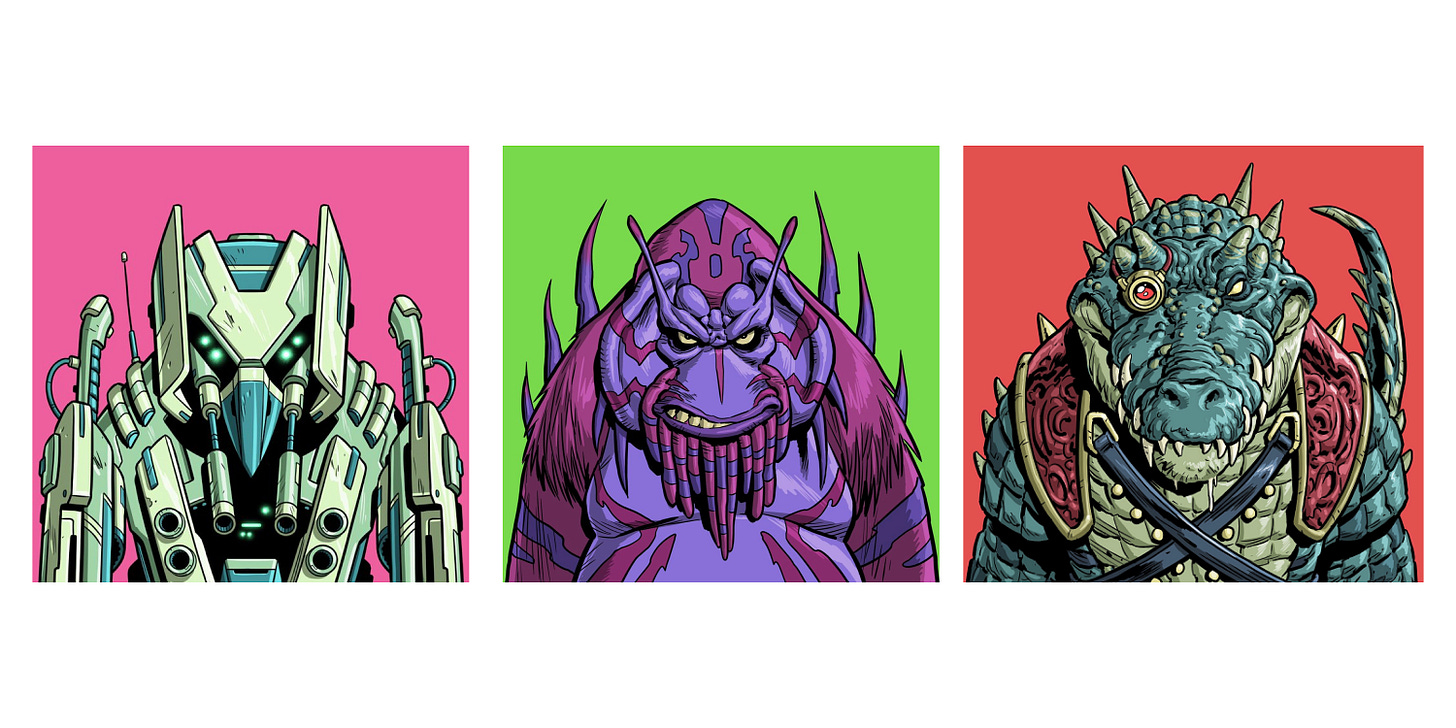
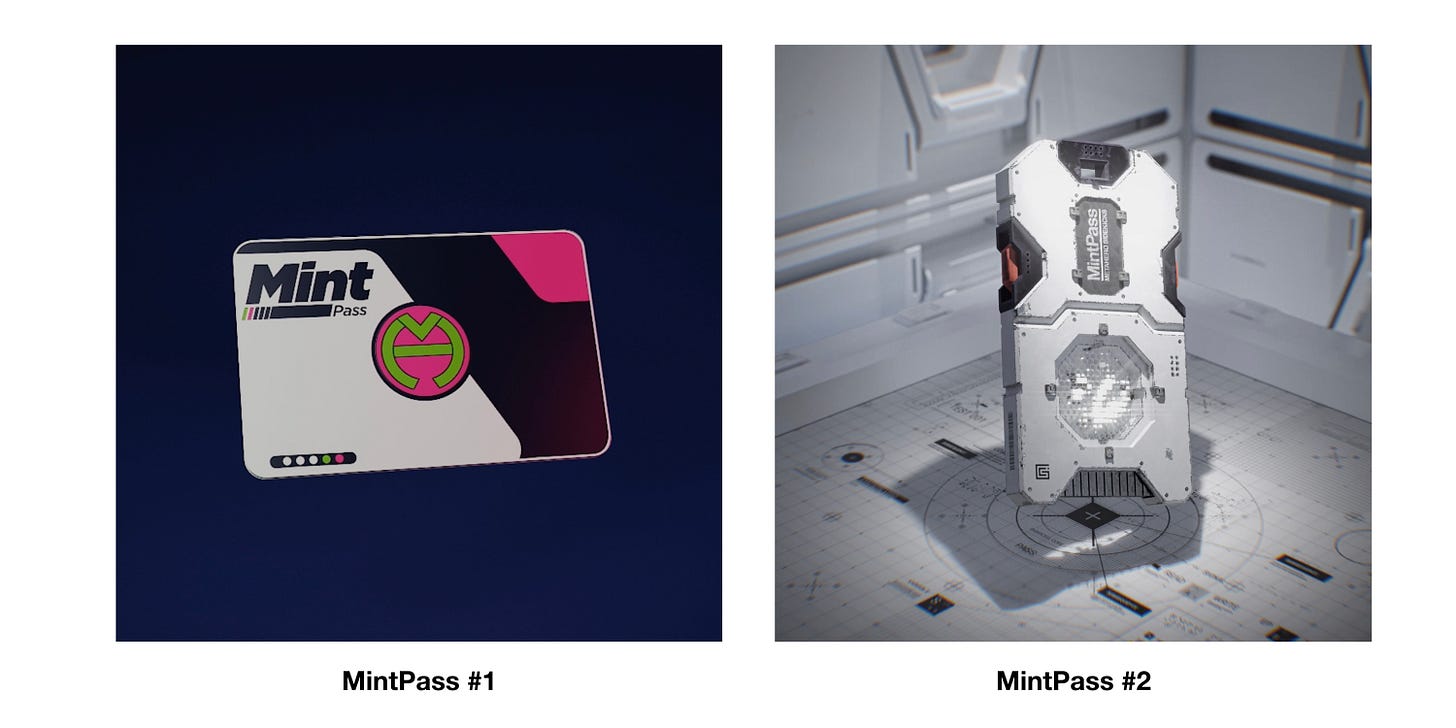

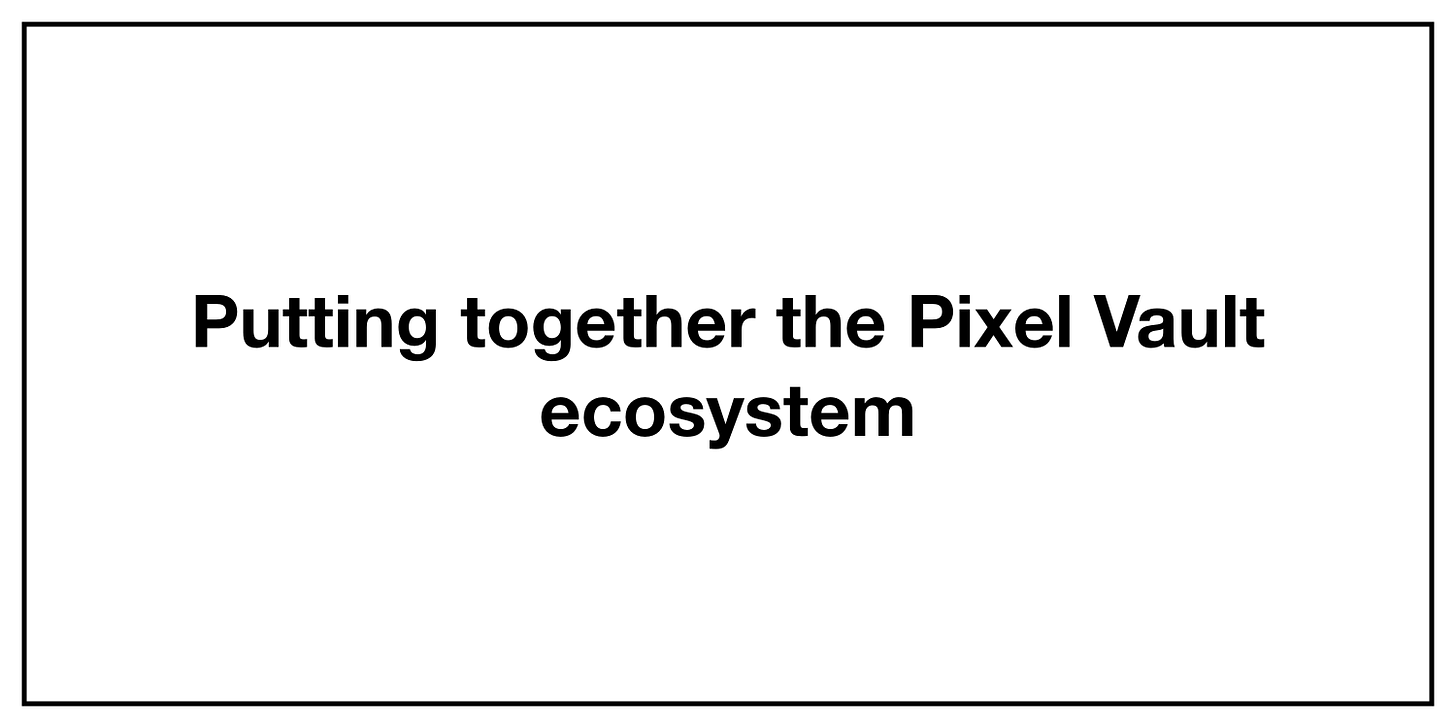


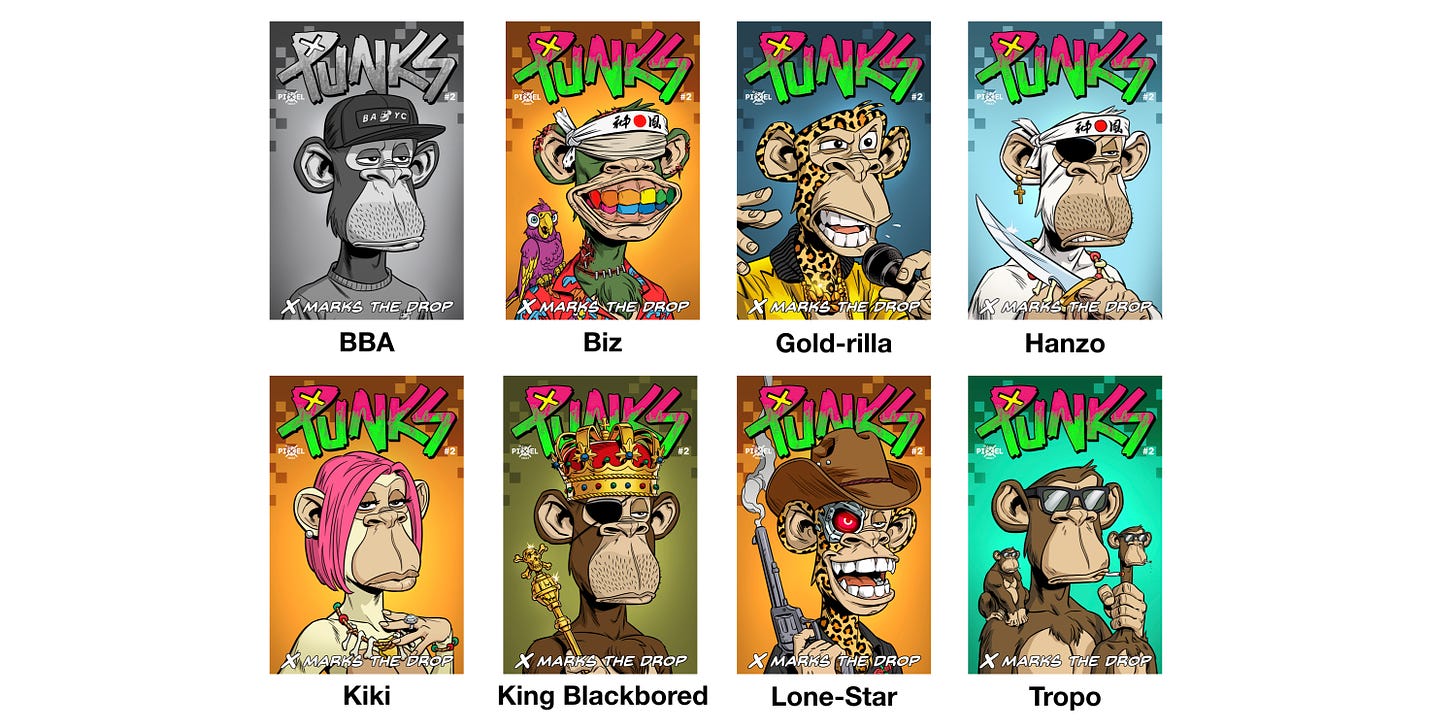
Spent 2 hours, in the early hours of the morning, researching PV + MHU for an interview. Should have just read this. At least I know I definitely have all I need to know! Thanks :)